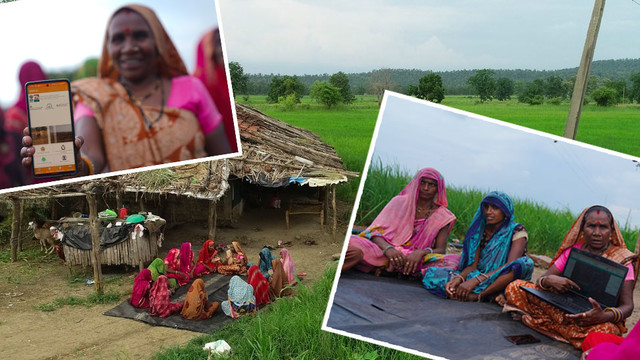Is this a climate change issue or a human rights issue?
This question was asked by a participant during a debrief from our field trip to Chapai Nawabganj district - a drought affected area north west of Dhaka, close to India. This field trip was part of the Fifth International Conference on Community Based Adaptation to Climate Change, being held in Bangladesh this week.
We had been driven for seven hours from Dhaka through hair-raising traffic to see some of the practical approaches that Caritas was using in their work with the Oraon Adivasi people. The Oraon Adivasi struggle to access both drinking water and water for their crops.
The challenges of increasing temperatures, erratic rainfall and poor access to information were being addressed by Caritas, in partnership with IIED. Caritas had tried to increase access to water by building rainwater harvesting structures, using sand filters to make pond water clean and safe to drink, and introducing drip irrigation. These interventions – which have built on indigenous practices like pond management, and have used locally available materials such as plastic bottles for drip irrigation – have been important in making efficient use of scarce rainwater. While these are all commendable and sustainable, they are only half the story.
The other half is found in understanding how the rights to use government-owned ponds and exploit groundwater are determined.
Inequality and vulnerability to climate change are inextricably intertwined
A stark illustration of the link between inequality and vulnerability to climate change was the contrast between an Adivasi plot of land and the adjacent paddy field.
The Adivasi plot and its spinach plants was irrigated by plastic bottles suspended overhead - a low-cost approach to drip irrigation that was making the most of a limited amount of rainwater collected from nearby ponds.
[flickr-photo:id=5570917705, caption=Drip irrigation using plastic bottles]
In contrast, next door was a field of paddy rice – lush and green with at least a foot of water on the field.
[flickr-photo:id=5570921299, caption=An irrigated paddy field]
The contrast between the two plots sparked an interesting discussion among Caritas staff about the policies that govern control of, and access to, water resources. Rich people are better placed to win competitive leases to use ponds and to access groundwater. While technical solutions like the plastic bottles are recognised by the community, achieving change at scale requires a more policy-oriented approach that tackles some of the root causes of inequality. We also need a better understanding of how interventions to improve access to water impacts the wider ecosystem.
Understanding wider ecosystem impacts
Later on the field trip we saw a UNDP funded irrigation scheme that used river water to provide water to over 1000 hectares of land. But finding information on the impact of the UNDP irrigation scheme on downstream river flows was difficult, as was knowing what kind of impact the use of water in the paddy field was having on the wider ecosystem.
When planning community level initiatives, development agencies have struggled to understand water systems at the ecosystem level. Collaboration between those familiar with ecosystem-wide impacts and those undertaking sustainable community development could be beneficial. We need to build on what has already been learned about facilitating processes that ensure equitable and sustainable entitlements to resources across a whole ecosystem.
Decentralising funding and strengthening downward accountability
Having the right information to choose appropriate interventions is important. But so too is having funding available for climate change adaptation at the local level. During the field trip we shared various examples of decentralised funding and decision-making models.
With funding comes responsibility and the need to strengthen financial accountability. We agreed that greater community organisation and involving these organisations in local government decision-making were vital first steps to improving accountability. And this could help encourage a more pro-poor approach to natural resource management. We discussed developing mechanisms for communities to hold local government to account for providing citizens with water. But we acknowledged that facilitating these processes takes a long time and can be politically sensitive, and consequently requires different skills and approaches from those needed to introduce new technologies to communities.
More two-way exchange?
The field trip and its subsequent debrief was a great success – though in future it would be nice to be able to explain to local communities why we were there and what we were going to do with the information collected. Nick Hall from Plan International suggested some ways in which visitors could give something back to local communities – for example showing short films of other field trips to local communities.
A big thanks to both Caritas and the Bangladesh Center for Adaptation Studies for organising the trip. We were treated with incredibly warm hospitality wherever we went, and the openness with which the team were prepared to discuss their programme helped to make it a rich learning experience for everyone involved!
This guest post was written by Kirsty Wilson who is Project Manager of Africa Climate Change Resilience Alliance (ACCRA) in Ethiopia. This is a consortium initiative of Care International, Oxfam and Save the Children.



